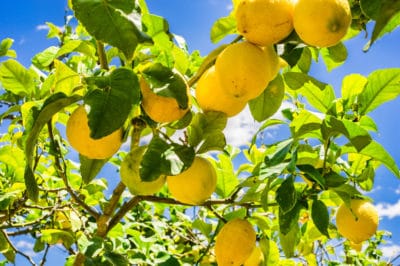Rootstocks and Grafting
A citrus tree’s rootstock is its lower, non-fruiting part. Grafting is the practice of joining budwood from one citrus tree’s fruiting upper part to the rootstock of another. Growers use grafting to combine the best traits of both trees.
Desirable rootstock traits include improved:
- Cold hardiness.
- Drought tolerance.
- Disease resistance.
Its rootstock also influences a lemon tree’s size. A tree grafted to a standard rootstock reaches 20 to 30 feet tall — with an equal spread — in 10 to 15 years.
Semi-Dwarfing Rootstocks
As you’d expect, picking the lemons from an orchard full of 20- to 30-foot trees has its challenges. By the 1950s, commercial growers were experimenting with rootstocks to make their trees smaller while maintaining their productivity.
Success came with trifoliate orange (Poncirus trifoliata) rootstock. Trees grafted to it saw their mature height and spread shrink to 12 to 15 feet. As impressive as that sounds, a 12- to 15-foot lemon tree is considered a semi-dwarf. Truly dwarf rootstocks didn’t arrive for another 50 years.
Rootstock US-897
Introduced in 2007, rootstock US-897 comes from crossing the trifoliate orange ‘Flying Dragon’ cultivar with the Cleopatra mandarin (Citrus reshni). When grafted to it, ‘Eureka’ lemons that would normally top out at 20 feet high need 10 years to reach 8 feet. They, and any trees growing just 6 to 10 feet tall, are classified as dwarf.
Pros and Cons of Dwarfing Rootstocks
Because they’re so much easier to pick, prune and maintain, semi-dwarf and dwarf lemons are a great choice for home growers. For anyone outside their outdoor growing range in USDA hardiness zones 9 through 11, dwarf lemons also make greatindoor container plants.
That said, dwarf trees sometimes have drawbacks:
- Their rootstocks are prone to suckering –- sending up shoots at the base of the trunk. Unless removed, they’ll engulf the entire tree.
- They’re less frost-and drought-resistant than larger trees.
- With smaller root systems to anchor them, they often need staking to help them grow upright.
But with a little extra tender loving care, each of these shortcomings is easily overcome.
